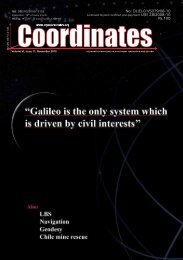Download - Coordinates
Download - Coordinates
Download - Coordinates
Create successful ePaper yourself
Turn your PDF publications into a flip-book with our unique Google optimized e-Paper software.
cartography, in GIS dominant<br />
model, GIS is placed at the helm<br />
of affairs and RS and cartography<br />
are treated as part of GIS.<br />
Modern cartography<br />
as integrating tool<br />
Today with arrival of satellite data,<br />
microprocessors and computer aided<br />
system i.e. GIS, We have modern<br />
cartography with various software<br />
(ARC/INFO, ERDAS, INTERGRAF,<br />
CARIS) which have been proved to<br />
integrate multimedia data layers into<br />
a required format and scale for better<br />
and faster charting practice. The recent<br />
development in modern cartography<br />
has proved their capabilities to produce<br />
nautical charts in analogue form and<br />
electronic navigational chart in the form<br />
of electronic navigational chart database<br />
(ENCDB) for requirement of safety and<br />
automated navigation. Preparation of<br />
chart involves the integration of various<br />
topographic and hydrographic source<br />
materials into a balanced and harmonic<br />
composition on a specified scale.<br />
National Hydrographic Office,<br />
Dehradun, India, under ministry of<br />
defense (Navy), is the pioneer office<br />
to produce nautical charts for marine<br />
safety navigation. To achieve the faster<br />
production of chart, NHO has been<br />
provided with modern cartographic<br />
division to integrate different types<br />
of ocean and topographic data into a<br />
required scale and projection with the<br />
help of INTERGRAPH workstation.<br />
Preparation of fresh compilation<br />
for nautical chart using original<br />
hydrographic and topographic data<br />
involves the digitization of various<br />
analogue data which is available in the<br />
form of survey fair sheet, toposheet,<br />
satellite imageries, tidal data, current<br />
data, sailing direction etc. on different<br />
scale and projection. The scope and<br />
purpose of modern cartographic<br />
section at NHO are as follow.<br />
(i) To create a fair drawing material<br />
(film positive and negative)<br />
from chart compilation.<br />
(ii) For auto compilation of various<br />
source data to create database for<br />
paper chart and ENC generation.<br />
(iii) To prepare electronic chart<br />
from existing chart database.<br />
The work procedure for production<br />
of nautical chart, involves inputting<br />
of data (hard copy and digital),<br />
preprocessing, compilation/auto<br />
compilation of various charts, ENC<br />
generation and chart preparation.<br />
The whole workflow is classified<br />
into five main activities as follow.<br />
(a) Data input: (Type and Source)<br />
(b) Data processing: Auto<br />
compilation, digitization and<br />
creation of master file.<br />
(c) Data output: Fair drawing<br />
and ENC generation.<br />
(d) Quality control: It is an issue, which<br />
can be controlled by verification<br />
and inspection at each step from<br />
data capture to presentation.<br />
(e) Records and reference.<br />
Application in support<br />
of nautical charting<br />
Nautical chart is a specialized map,<br />
which is a legal tool for marine<br />
navigational safety and research. It<br />
is specifically designed to meet the<br />
requirement of marine navigation<br />
showing depth of water, nature of<br />
bottom, elevation and configuration of<br />
coast, danger and aids to navigation.<br />
Modern cartographic tools are being<br />
increasingly used world over for ocean<br />
and land management application.<br />
Digital Photogrammetry and image<br />
processing of remote sensing data<br />
jointly meet the mapping requirement<br />
of coastal and hydrographic<br />
management application. In addition<br />
to this technology, tools for integrating<br />
various thematic data and generation<br />
of hydrographic database for paper<br />
and ENC chart production are now<br />
available with modern cartography.<br />
Based on experience of other<br />
International hydrographic offices,<br />
National Hydrographic Office,<br />
Dehradun also expects to utilize<br />
modern cartographic tools for nautical<br />
charting in the following ways.<br />
(a) Modern cartographic tools<br />
are useful for the generation<br />
of paper chart database and<br />
electronic navigational chart<br />
database (ENCDB) to produce<br />
paper chart and ENC.<br />
(b) To meet the greater demand of<br />
chart for safety of navigation, it<br />
provides the faster production<br />
of nautical charts.<br />
(c) It is highly utilized in generation<br />
of grids, graticules, ticks, labels,<br />
projection scales and map legend<br />
during auto compilation of charts.<br />
(d) It can be effectively depict<br />
low tide line, high tide line,<br />
nature of coastline, danger line<br />
and isolated shoal patch on<br />
chart for safety navigation.<br />
(e) Modern cartography plays<br />
a vital role to collect and<br />
represent accurately the valuable<br />
topographical information including<br />
conspicuous objects along coast,<br />
which are aids to navigation.<br />
(f) It is widely applicable to<br />
integrate multi thematic data<br />
and RS data into digital format<br />
for terrain measurement and<br />
management to study coastal<br />
resource development. The modern<br />
cartography in conjunction with<br />
GIS, RS, Photogrammetry, GPS<br />
and modeling tools is enable to<br />
shoreline mapping, coastal highway<br />
and gas pipeline mapping, coastal<br />
habitats and low water features<br />
representation in support of coastal<br />
zone management chart production.<br />
(g) It is capable to analyze and<br />
integrate spatial data in requisite<br />
projection and all scale ranging<br />
from 1: 1000 to 1: million as<br />
required to produce large scale<br />
to small scale nautical chart.<br />
Further improvement in modern<br />
cartography with aid of information<br />
technology will provide valuable<br />
information to represent marine<br />
features such as pinnacle rock,<br />
wreck, navigational buoys, beacon<br />
etc. that are important in nautical<br />
charting for safety navigation.<br />
Conclusion<br />
Modern cartographic techniques are<br />
being increasingly used world over<br />
40 April 2006

















